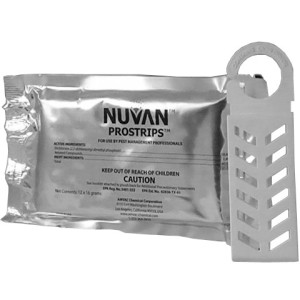Proper Use of No-Pest Strips in Your Home
By Chris Williams on February 11, 2014.
 It has come to my attention that some of our customers don’t know how to use No-Pest Strips properly or safely. I’m talking about those yellow resin or plastic strips that you can hang in enclosed spaces to kill certain pests. “Enclosed spaces” is the operative word here. I’ll explain more later.
It has come to my attention that some of our customers don’t know how to use No-Pest Strips properly or safely. I’m talking about those yellow resin or plastic strips that you can hang in enclosed spaces to kill certain pests. “Enclosed spaces” is the operative word here. I’ll explain more later.
When I was young, the Shell No-Pest® Strip was readily available. Today the product you see in stores is the Hot Shot® No-Pest®Strip. A similar product, the Nuvan® Prostrip™, is used by pest control professionals. All of the No-Pest strips are impregnated with the pesticide dichlorvos, also known as DDVP, and sometimes called Vapona by oldtimers. Dichlorvos is an organophosphate type of pesticide. Most organophosphates have been banned over the years for various reasons, but DDVP strips survived the cut because of their high volatility and specialty use as a pest fumigant.
No-Pest Strips give off dichlorvos vapors, essentially fumigating the space in which they are placed. The strips are designed to be used in spaces that can be closed off and not occupied for extended periods. No-Pest Strips kill household pests such as flies, cockroaches, silverfish, clothes moths, spiders, beetles, and earwigs. Placed properly, they are effective for up to 4 months. The yellow resin strips are enclosed in a plastic holder that can be hung or stood up in the area to be treated. But the area to be treated cannot be:
- a living space
- a kitchen
- a space that people or pets occupy more than 4 hours a day
- space that is smaller than the minimum treatment area allowed by the label
The Centers for Disease Control (CDC) recently reported on a 13-year study of 31 poisoning cases resulting from misuse of No-Pest Strips. Most of the illnesses reported by the CDC occurred when people were exposed to the strips for more than 4 hours a day. Fortunately, victims of dichlorvos overexposure recover quickly once removed from the treated area.
Allowed Uses of Dichlorvos No-Pest Strips (but read the label!)
- No-Pest Strips are useful for fumigating infested items that can’t be washed or treated with liquid pesticides, heat, or other methods. The items and No-Pest Strip are placed in a closed-off closet or other room that is not occupied for an extended period of time. Items must be aired-out for at least 2 hours after treatment and before use.
- No-Pest Strips can be used to kill pests in larger spaces like cabins, vacation homes, mobile homes, and boats only if these spaces remain unoccupied for at least 4 months after placement of the strips.
- No-Pest Strips can be used, according to label directions, in parts of a home that are not occupied for more than 4 hours a day such as garages, attics, and crawlspaces.
Precautions When Using Dichlorvos No-Pest Strips
- Wash hands with soap and water after handling strip.
- Do not remove the strip from its holder or cut it into smaller pieces.
- Do not place strips in living areas like bedrooms or family rooms.
- Do not place strips in kitchens or anywhere that food is handled or served.
- Do not allow children or pets to sleep or play in areas where strips have been placed.
- Never place a No-Pest Strip in or around a bed to kill bed bugs. Hot Shot® markets a Bedbug Mattress & Luggage Treatment Kit that includes a 16 gram dichlorvos strip and a king size mattress treatment bag which can also be used to treat luggage.
- Do not overapply. One 65 gram strip will treat 900-1200 cubic feet, about the size of a 10 x 13 room with an 8 foot ceiling.
Remember, if you really want to eliminate pests and assure the safety of your family, call a professional.